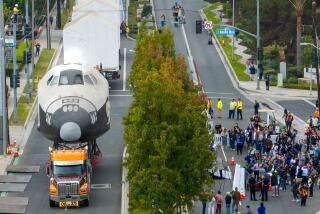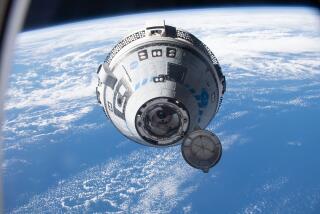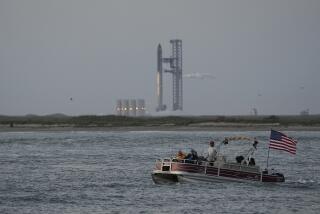‘Jewel’ of Shuttle Fleet Debuts : Space: Endeavour, the replacement for Challenger, comes off the production line in Palmdale. It is more advanced than earlier craft.
The $1.8-billion space shuttle Endeavour officially rolled off the Rockwell production line in Palmdale on Thursday, replacing the ill-fated Challenger and bringing NASA’s space fleet back to its full complement of four vehicles.
To the majestic strains of “Thus Spake Zarathustra”--the theme from the movie “2001: A Space Odyssey” and the unofficial anthem of the space generation--the five-story tall, gleaming white craft made its official debut before a crowd of 3,000 employees and well-wishers at Air Force Plant 42. NASA will not officially take delivery, however, until Endeavour is flown piggyback on a 747 to the Kennedy Space Flight Center in Florida this weekend.
Although the orbiter will not actually be completed until after it reaches Florida, NASA officials and astronauts waxed poetic over it.
“Endeavour, the jewel of the fleet! Isn’t it beautiful?” remarked astronaut Daniel Brandenstein, who will command the shuttle on its maiden voyage in March, 1992, a mission to bolt a new rocket motor onto a failed communications satellite. “I tell you, if that doesn’t put a lump in your throat, I don’t think you’re human.”
“Endeavour is a beauty,” said NASA Administrator Richard Truly, “but in this case beauty is more than skin deep. This orbiter’s not like the others. It’s equipped with the latest avionics (navigation equipment), the finest mechanical systems, a new drag chute and equipment for longer duration flights.”
Endeavour incorporates all the improvements that have been made on the other three shuttles, and some that won’t appear on those shuttles until later. The most obvious is a drag parachute that will be deployed on landing to slow the orbiter, thereby easing the pressures on the brakes and landing gear.
The parachute and a newly beefed-up nose wheel will also increase control of the shuttle when it is forced to land on the concrete runway at the Kennedy center rather than the longer and wider dry lake bed at Edwards Air Force Base.
Endeavour also contains more fuel cells, which generate electricity, to allow it to stay in orbit for as long as 28 days, twice as long as the existing craft. NASA plans to make longer flights in the future to study the effects of microgravity on astronauts.
At the ceremony, Brandenstein was presented with part of the sternpost recovered from the first Endeavour, a research ship commanded by British explorer Capt. James Cook between 1768 and 1771. The centuries-old memento will be carried into space on Endeavour’s first mission.
Endeavour joins Discovery, Atlantis and Columbia, which were also named after seagoing research vessels. The new vessel’s name was suggested by schoolchildren from Senatobia, Miss. and Tallulah Falls, Ga., who were present for the rollout.
It replaces the Challenger, which exploded 73 seconds after liftoff on Jan. 28, 1986, killing all seven aboard.
Former President Reagan authorized the replacement for Challenger in 1987. The quick construction was possible in part because Rockwell had a set of wings, a crew cabin, a tail fin and other major structural components available as backups for the fleet. These were all incorporated into Endeavour.
But the orbiter is still missing a nose-mounted cluster of steering rockets that will not be delivered until July, and its three main rocket engines will not be installed until September. Two small maneuvering rockets also are not finished, and Endeavour will make its first flight with two borrowed from Columbia.
The Newest Shuttle: Endeavour NASA’s newest space shuttle incorporates many modifications, upgrades and technologies added to the orbiter fleet over the past several years. 1. Hydraulic system: Improved power units are lighter and last longer. 2. Navigation system: Includes more powerful computers, new star tracker and a new inertial navigation system. 3. Nose-wheel steering: New backup system in case the primary one fails. 4. Extended duration: Modifications include more storage space, trash compactors, carbon dioxide removal system and more fuel cells. 5. Improved brakes: Helps craft stop in a shorter distance. 6. Drug chute: To aid deceleration and reduce load on landing gear and brakes. Source: NASA, Rockwell International
More to Read
Sign up for Essential California
The most important California stories and recommendations in your inbox every morning.
You may occasionally receive promotional content from the Los Angeles Times.










